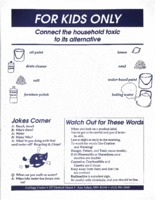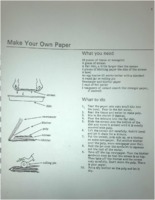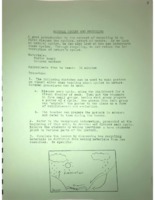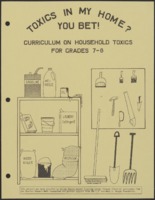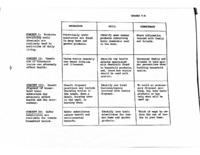See a related article from the Ecology Center's website, Connecting Learning with Action: the Ecology Center’s Recycling Education Program
Developing Curricula for Ann Arbor Public Schools
"I think kids are intrinsically interested in just about everything ... if there's an opportunity for them to see the bigger picture without making it too scary…[to open] it up so that kids have a chance to see a situation and how they can make a difference, and not throw out all the answers in front of them because honestly the best answers come from many people looking and discussing things and bringing that kind of creativity into the classroom...[is] what makes it happen.” - interview with Nancy Stone, Former Environmental Education and Membership Coordinator at the Ecology Center, July 3, 2019
For the Ecology Center, educating the next generation of environmentalists was all about empowerment. As Nancy Stone describes in her July 3, 2019 interview, EC educators were in a unique position to explain environmental topics to students in a way that made them excited rather than fearful about the tasks ahead. The education outreach team firmly believed that children were an important influence on changing their parents’ habits regarding recycling, disposing of household toxics correctly, and other daily practices with environmental impacts.
The Ann Arbor Public School system (AAPS) took this approach as well, and were also looking for ways to meet the state’s requirement to include environmental education as part of their curricula. By bringing EC staff into the classroom, teachers could help raise awareness about environmental issues while building enthusiasm among students for classroom visitors. Thanks to the efforts of educational specialists and staff members like Wendy Wilson, Nancy Stone, and Tara Ward, the Ecology Center built a lasting partnership with AAPS and used classroom visits as a way to put their curricula on recycling and household toxics into practice.
Recycling Education Comes to the Classroom
The Ecology Center first began designing and implementing environmental curricula for AAPS on the topic of recycling. According to Nancy Stone, AAPS did not have a school-wide recycling service in the mid-1980s, and any recyclable materials that were collected in school had to be sent home with students for their own curbside collection or taken to the municipal Drop-off Station. Collaborating with Recycle Ann Arbor, the EC saw developing a program for schools as an opportunity to make recycling part of students’ daily routines. The EC piloted school collection services in three to four schools, and encouraged classes to make and decorate their own classroom recycling bins.
Wendy Wilson was the environmental education coordinator for the Ecology Center in the early 1980s. As one of the founders of Recycle Ann Arbor, she made recycling education a priority in her early classroom visits. Drawing on her training as a naturalist from the University of Michigan's School of Natural Resources and the Environment, Wilson emphasized hands-on, interactive lessons. In an interview from June 21, 2019, she explains:
"I knew that the kids really loved getting involved and wanted to do more than just go on a nature hike and that they could be a really good source of inspiration to families to actually get out there and participate in the recycling program. I think that really worked because the teachers would know that they could have us come and then they would be able to follow up with programs in the school and ask kids to get extra credit by actually going home and helping their parents recycle.”
In1984, the EC published an official recycling curriculum for students in grades K-12. Authored by Sharon Edwards and Laurie Miller, the curriculum emphasized building awareness, increasing hands-on experiences with recycling, and understanding how students could make a difference in their own communities. Activities included making paper, building a can crusher, and completing a “household toxics hunt.” Additionally, the activities for high school students emphasized role-playing scenarios to encourage young people to learn to make sustainable and eco-friendly purchases.
Toxics in My Home? You Bet!
By the mid-1980s, the Ecology Center had also made great strides in educating the public about the dangers of household toxic chemicals. They had successfully run annual Household Toxics Collection Days and became involved in the “Right-to-Know” Campaign. Educational outreach was the next logical step to bring knowledge about household toxics to the next generation.
In the video at left, Nancy Stone explains the broader reasoning for developing this curriculum. Improper disposal of household chemicals can cause bigger problems in terms of landfill overuse and polluting groundwater. She states ...
"The Ecology Center was working very closely with Washtenaw County to have a home toxics collection program because it was definitely coming up that a lot of the stuff people were just throwing in the trash doesn’t belong to [the] recycling bin, but it also really doesn’t belong to landfills either. And [we were] trying to understand [and] communicate how landfills operate and how they’re, in some ways they’re a vault, but they’re not an impervious vault. There are consequences for the things you put in there.”
In 1986, thanks to the efforts of policy specialist Jim Bernard and educational specialist Tara Ward, the Ecology Center received a grant from the C.S. Mott Foundation to develop their curriculum, titled “Toxics in My Home? You Bet!” Based on a similar program designed for middle school students in Sacramento, CA, the curriculum emphasized three key skills: recognizing chemical hazards; reducing exposure to pesticides, solvents, and chemicals; and knowing about the least harmful disposal methods for these chemicals. These skills were developed over four units, each featuring a central concept. The four key concepts were:
- Concept 1: Toxics are Routinely Used
- Concept 2: Toxics Can Adversely Affect health
- Concept 3: Unsafe Disposal Practices Create Problems
- Concept 4: Safer Substitutes are Available
To get out the word the Ecology Center published and distributed the curriculum for free at conferences and teacher in-services.
Due to the program’s success, the Mott grant was renewed for $29,000 in 1987 that enabled the program to expand in several exciting ways. Lise Anderson, Susan Gardner, and Charles Griffith collaborated on an instructional video for teachers, titled Making the Connection: A Teacher’s Guide to Household Hazardous Substances and the Classroom. The curriculum was extended to include high school students, and also led to the publication of the Michigan Household Hazardous Substances Handbook, which were distributed to policy makers, government officials, and local nonprofits.

